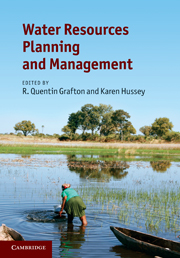Book contents
- Frontmatter
- Contents
- List of contributors
- Foreword
- Preface
- Acknowledgements
- Introduction
- Part I Understanding ‘water’
- 1 Climate change and the global water cycle
- 2 Understanding global hydrology
- 3 Groundwater and surface water connectivity
- 4 Understanding the basics of water quality
- 5 Inland water ecosystems
- 6 Water, biodiversity and ecosystems: reducing our impact
- 7 Global food production in a water-constrained world: exploring ‘green’ and ‘blue’ challenges and solutions
- Part II Water resources planning and management
- Part III Water resources planning and management: case studies
- Contributors
- Index
- References
2 - Understanding global hydrology
from Part I - Understanding ‘water’
Published online by Cambridge University Press: 05 August 2011
- Frontmatter
- Contents
- List of contributors
- Foreword
- Preface
- Acknowledgements
- Introduction
- Part I Understanding ‘water’
- 1 Climate change and the global water cycle
- 2 Understanding global hydrology
- 3 Groundwater and surface water connectivity
- 4 Understanding the basics of water quality
- 5 Inland water ecosystems
- 6 Water, biodiversity and ecosystems: reducing our impact
- 7 Global food production in a water-constrained world: exploring ‘green’ and ‘blue’ challenges and solutions
- Part II Water resources planning and management
- Part III Water resources planning and management: case studies
- Contributors
- Index
- References
Summary
In this chapter we set out to discuss surface hydrology at the global scale and in doing so we will place emphasis on surface runoff, both direct and as baseflow, since this is the harvestable part of the hydrologic cycle. Of all the freshwater on Earth, only about 0.3% is surface water while the rest is frozen in the ice caps and glaciers or in the groundwater (Gleick, 1996). Yet it is this surface water that we are most familiar with and that, globally, provides 83% of the water we use (2030 Water Resources Group, 2009). It is runoff that constitutes the water resource. Part of the flow of rivers can come from groundwater (as baseflow) and in particular locations groundwater can be the most important water source. Also, we will concentrate on ‘natural’ hydrology, rather than hydrology as impacted by water resources development. It is, however, becoming increasingly difficult to isolate natural hydrology from hydrology as affected by human impacts. There are few major river systems that are not now significantly regulated. For example, the Yangtze River basin in China, with an area of 1808500 km2, is estimated to contain 50 000 dams – an average of one dam for every 36 km2 of basin area and providing a total storage capacity nearly one-quarter of the annual flow of the river. Some 64% of the total storage capacity is in 119 large reservoirs, each greater than 0.1 × 109 m3 (Yang et al., 2005).
- Type
- Chapter
- Information
- Water Resources Planning and Management , pp. 23 - 45Publisher: Cambridge University PressPrint publication year: 2011
References
- 2
- Cited by

